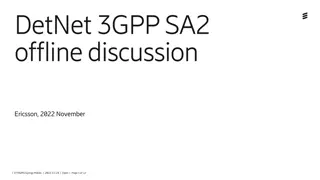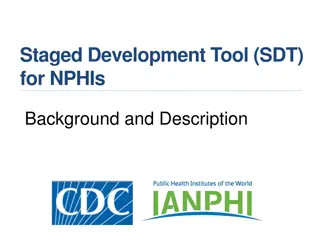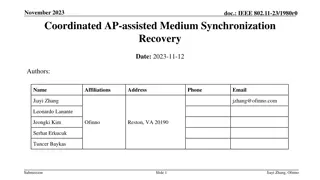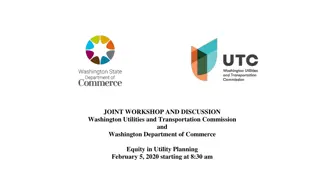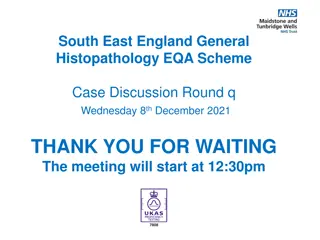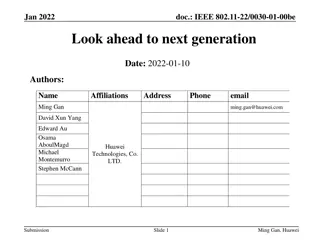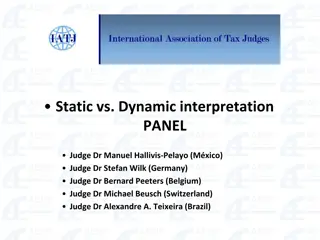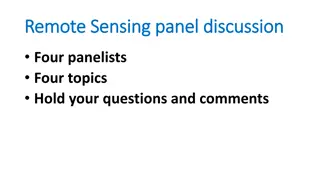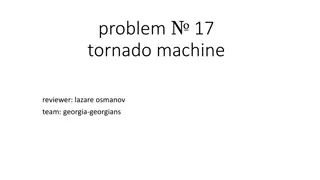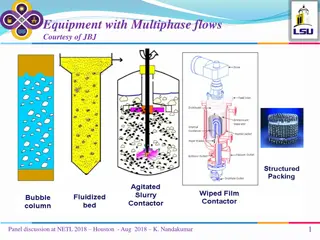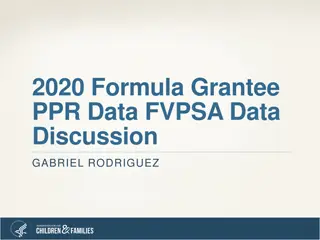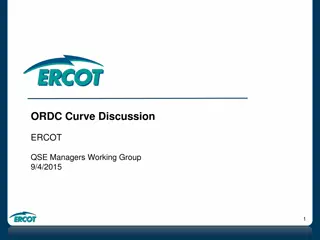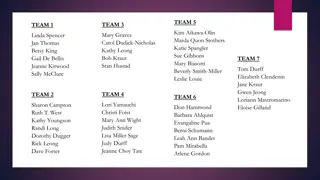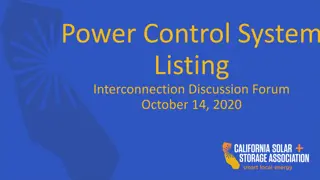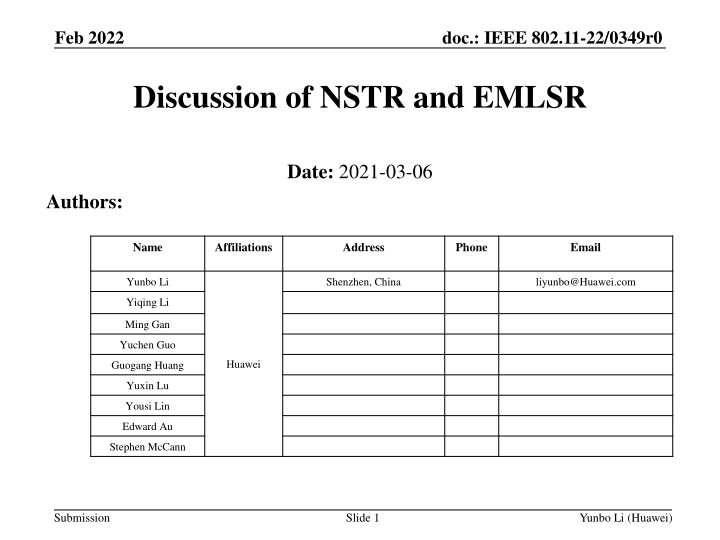
Discussion of NSTR and EMLSR in IEEE 802.11-22/0349r0 Feb 2022
Explore the significance of EMLSR compared to NSTR in IEEE 802.11-22/0349r0 Feb 2022 documentation. Discover the mandatory support for operation with non-AP MLD and the proposal to make EMLSR support mandatory on the AP MLD side for improved efficiency. Dive into performance comparisons and the complexities involved in supporting EMLSR alongside NSTR and STR modes.
Download Presentation

Please find below an Image/Link to download the presentation.
The content on the website is provided AS IS for your information and personal use only. It may not be sold, licensed, or shared on other websites without obtaining consent from the author. If you encounter any issues during the download, it is possible that the publisher has removed the file from their server.
You are allowed to download the files provided on this website for personal or commercial use, subject to the condition that they are used lawfully. All files are the property of their respective owners.
The content on the website is provided AS IS for your information and personal use only. It may not be sold, licensed, or shared on other websites without obtaining consent from the author.
E N D
Presentation Transcript
doc.: IEEE 802.11-22/0349r0 Feb 2022 Discussion of NSTR and EMLSR Date: 2021-03-06 Authors: Name Affiliations Address Phone Email Yunbo Li Shenzhen, China liyunbo@Huawei.com Yiqing Li Ming Gan Yuchen Guo Huawei Guogang Huang Yuxin Lu Yousi Lin Edward Au Stephen McCann Submission Slide 1 Yunbo Li (Huawei)
doc.: IEEE 802.11-22/0349r0 Feb 2022 CID 5773 CID 5773Laurent Cariou 35.3.15 Commenter Section Page.Line 281.17 Comment eMLSR has been introduced a bit late compared to other modes like NSTR and has therefore been introduced as optional. However, support for operation with non-AP MLD with the other main modes is mandatory at the AP MLD side (NSTR, STR). It would make sense that all the main modes are actually mandatory supported on all AP MLDs. On top of that, eMLSR has shown significant gains and is clearly a very important features for MLO in 11be. Also complexity to support eMLSR for an AP MLD that already supports operation for NSTR or STR non-AP MLD is relatively minor. Proposed Change Make eMLSR support mandatory on AP MLD side. Resolution Submission Slide 2 Yunbo Li (Huawei)
doc.: IEEE 802.11-22/0349r0 Feb 2022 Background A link pair in an AP MLD, except mobile AP MLD, is mandate to be STR. A link pair in a non-AP MLD could be STR, NSTR, MLSR, or EMLSR; Considering the differences between AP MLD and non-AP MLD (e.g. cost, size, etc.), it is normal that AP MLD side can achieve STR while non- AP MLDs cannot; MLSR can reach limited gain by selecting a better link based on the traffic load, but cannot increase the throughput or reduce the latency through ML operation. MLSR will obviously have a worse performance than NSTR and EMLSR; This presentation mainly discusses NSTR and EMLSR. Submission Slide 3 Yunbo Li (Huawei)
doc.: IEEE 802.11-22/0349r0 Feb 2022 Performance loss compared with STR NSTR In UL channel access, the link finished the backoff first needs to wait for another link of the NSTR link pair if the non-AP MLD intends to simultaneously transmit on two links; When AP MLD schedules the UL/DL transmission, due to cross link interference constrain at non-AP MLD side, needs to be considered Blindness of one link due to the transmission on another link exceeds the MediumSyncThreshold; EMLSR Overhead of initial control (MU-RTS/CTS, or BSRP/BSR) Overhead of switch delay between receiving mode and listen mode Blindness once a link switches back to listening mode Submission Slide 4 Yunbo Li (Huawei)
doc.: IEEE 802.11-22/0349r0 Feb 2022 Comparison between NSTR and EMLSR NSTR EMLSR MIMO Flexible to be SISO or MIMO Mandatory to support MIMO RF switch No Frequent Peak throughput (1+1 for NSTR; 2*2 for EMLSR) higher Lower due to Lower MCS for 2SS Sounding cost Whether UL Data transmission in link 1 will cause blindness in link2 No for single short packet (<72us) ; Yes for long packet ( 72us) Yes Whether DL Data transmission in link 1 will cause blindness in link2 No for most cases. Because, in many cases, BA is shorter than MediumSyncThreshold Yes Delay (for short frame) May be better than EMLSR due to less chance to enter blindness May be worse than NSTR due to higher chance to enter blindness Submission Slide 5 Yunbo Li (Huawei)
doc.: IEEE 802.11-22/0349r0 Feb 2022 Setting of System Level Simulation Parameters Value # of AP MLDs 2 # of affiliated APs for each AP MLD 2 # of associated non-AP MLDs for each AP MLD 8 coverage of BSS 10 m * 10 m Distance between two AP MLDs 30 m BW 80 MHz MCS 11 Traffic direction UL + DL DL PPDU type MU-MIMO (4*4) UL PPDU type MU-MIMO for TB PPDU (4*4); SISO for NSTR EDCA; 2*2 MIMO for EMLSR EDCA MPDU size 1500 Bytes Switch delay of EMLSR 128 us Blindness period 5.484 ms Submission Slide 6 Yunbo Li (Huawei)
doc.: IEEE 802.11-22/0349r0 Feb 2022 Simulation Results of Throughput Max number of aggregation = 256 Submission Slide 7 Yunbo Li (Huawei)
doc.: IEEE 802.11-22/0349r0 Feb 2022 Simulation Results of Delay MPDU size = 200 Bytes Submission Slide 8 Yunbo Li (Huawei)
doc.: IEEE 802.11-22/0349r0 Feb 2022 Summary When a link pair of a non-AP MLD cannot realize STR, there are three possible modes to choose: NSTR, MLSR and EMLSR. Based on the performance analysis, NSTR is the best, EMLSR is the second, and MLSR is the worst; NSTR and MLSR are already mandatorily supported at AP MLD side, a non-AP STA could choose NSTR for better performance, or MLSR for simple operation; Mandate EMLSR at AP MLD side will add too many options which add the complexity at AP MLD side; Suggest to keep EMLSR as an optional feature. Submission Slide 9 Yunbo Li (Huawei)
doc.: IEEE 802.11-22/0349r0 Feb 2022 Straw Poll Do you agree to resolve CID 5773 as below? CID 5773Laurent Cariou 35.3.15 Commenter Section Page.Line 281.17 Comment eMLSR has been introduced a bit late compared to other modes like NSTR and has therefore been introduced as optional. However, support for operation with non-AP MLD with the other main modes is mandatory at the AP MLD side (NSTR, STR). It would make sense that all the main modes are actually mandatory supported on all AP MLDs. On top of that, eMLSR has shown significant gains and is clearly a very important features for MLO in 11be. Also complexity to support eMLSR for an AP MLD that already supports operation for NSTR or STR non-AP MLD is relatively minor. Proposed Change Make eMLSR support mandatory on AP MLD side. Resolution Rejected. Base on the performance analysis in doc 11- 22/0349r0, NSTR is the best, EMLSR is the second, and MLSR is the worst. Since NSTR and MLSR already been mandated at AP MLD side, mandating EMLSR at AP MLD side will add too many options which add the complexity at AP MLD side. Submission Slide 10 Yunbo Li (Huawei)

